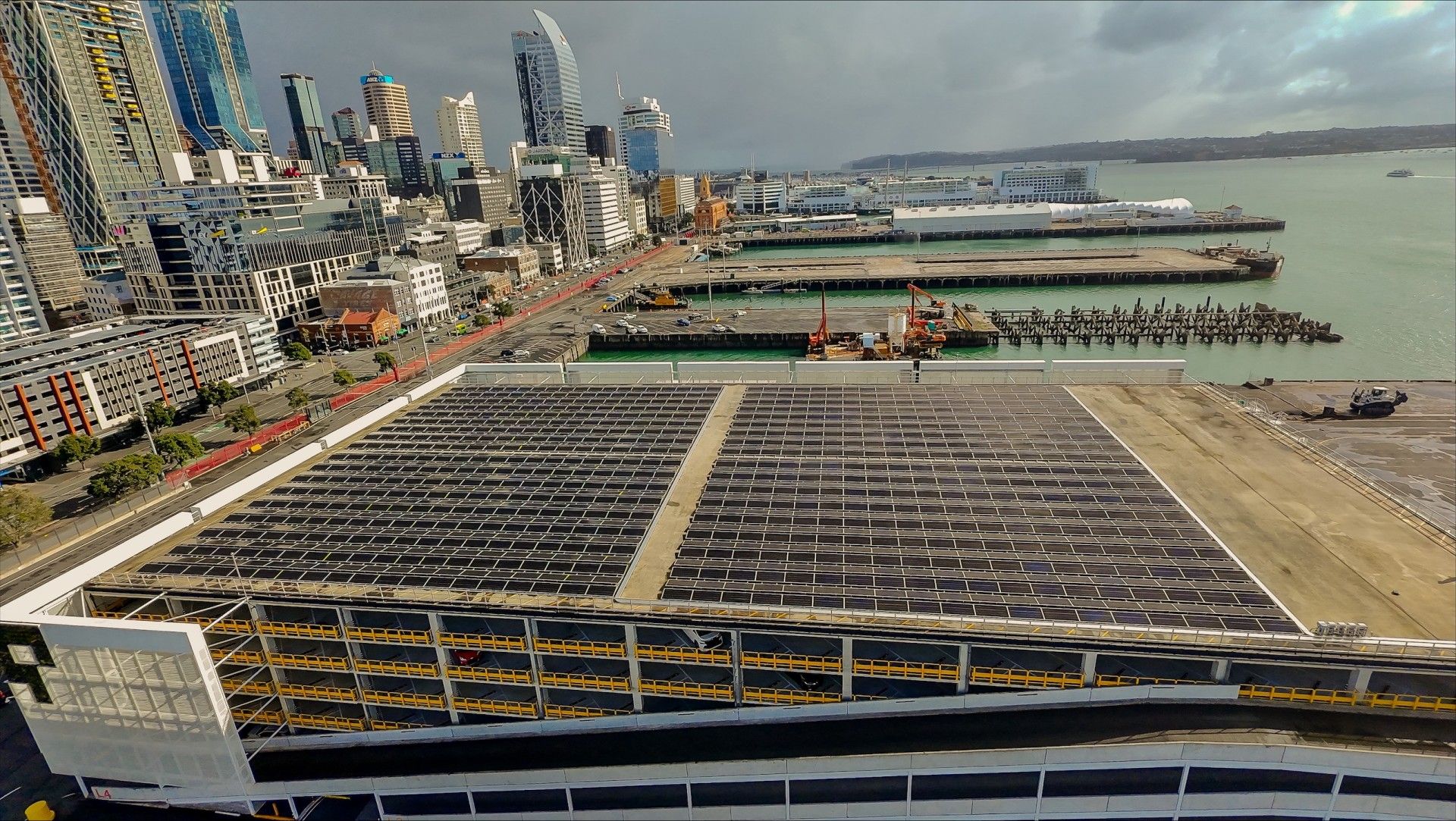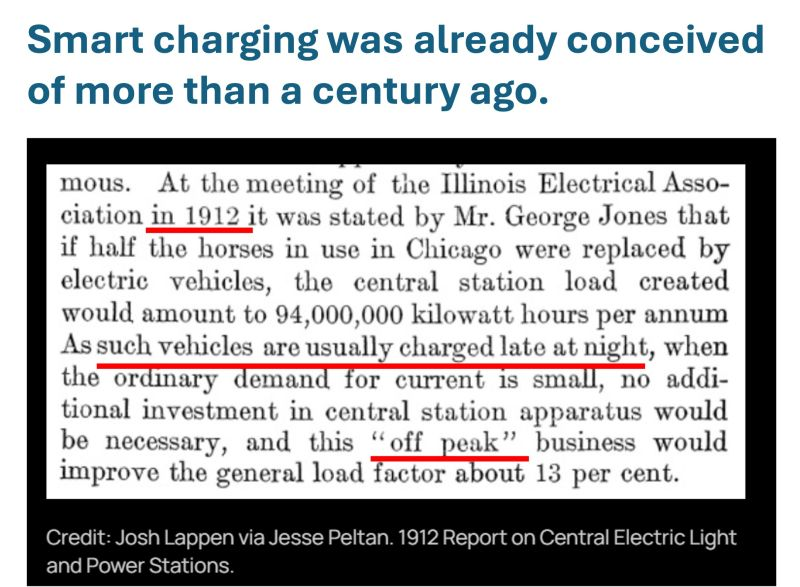The case for energy loans: read our latest explainer



Auckland CBD's biggest solar install shows that existing rooftops - big and small - are an easy win for electricity generation; New Zealand researchers leading the world on solar efficiency; a clever scheme to train up more heat pump installers in the UK; a very early example of loadshifting; and electric school buses hit the road in the US.

Look up
The stars continue to align for solar and, as Jack Tame said on Newstalk ZB, it’s largely because it’s so cheap.
New Zealand is starting from a low base, but the message is hitting home here, too, and a big install just got switched on at the Port of Auckland, with more to come.
This is the port's first large-scale solar installation, and currently the biggest in Auckland's CBD. The 1,344 solar panels are expected to produce around 876 MWh of renewable electricity annually. That’s enough to power about 100 homes, or roughly six percent of the port’s current grid energy use.
It’s a major milestone in our push to reduce emissions and strengthen the resilience of our power network. As ports around the world transition to low-carbon futures, this is a significant step towards our own electrification goals.
We're also planning more solar installations, including on the roof of our main building at Fergusson Wharf as part of its refurbishment.

Last year, research from AUT showed that the 14 biggest rooftops in Auckland would generate more electricity than the country’s biggest solar farm and the same amount of solar power could be distributed “evenly to communities by utilising the rooftops of schools and supermarkets, totalling 167 buildings”.
In some countries, it is now compulsory to put solar on new structures like car parks (and, a bit like Kiwisaver, it requires some fairly good evidence to opt-out). In Germany, they’re even putting panels alongside motorways.
There are also lots of large farm buildings crying out for solar and we’re in agreement with Federated Farmers that we should be putting more solar on rooftops and unproductive land, rather than turning productive land into solar farms.
We shouldn’t forget our small residential rooftops, either. A lot of a little is a lot and, in Australia, the panels that are now on more than one in three homes now accounts for over 12% of the country’s total electricity generation. The UK has mandated all new residential buildings will need to have solar installed, starting in 2027.
More electrons

Solar and batteries are energy technologies, where their efficiency can potentially improve at Moore’s Law levels, just like computers (that isn’t the case with fossil fuels). And researchers in New Zealand are leading the way and potentially hitting levels never seen before in solar panels.
As B2B News reported, Victoria University’s Dr Nate Davis says his work points to a possible 44% conversion rate, exceeding the widely accepted 32% threshold.
“It’s something people have been trying to solve for 30 years. It’s a big, big problem, with our technology, theoretically you can get to 44%” he said.
The key to Davis’s success lies in a process called singlet fission, which allows a single high-energy photon to produce two electrons instead of one—dramatically increasing power output. While the principle has been explored in elite labs before, Davis has applied it in a new way, within hybrid solar cells made from perovskites and organic/inorganic nanomaterials.
The thought of having solar panels on all kinds of surfaces is compelling and, as the price drops, it’s starting to come true and even being used for fencing, but Davis says the “solar panels could be produced using existing printing technology, potentially avoiding traditional factory-based manufacturing”.
“Some of the guys we talked to in America have the old Kodak facilities and they’re making solar panels on the Kodak printers,” he said. “If we could print solar panels that are more efficient than silicon, they would just put them everywhere.”
Home fires not burning
We’re going to need a massive number of tradies to electrify everything, and that will require a fair bit of training as installers move away from gas systems and towards cheaper, cleaner electric equivalents. So how do you incentivise more people to get involved and learn the ropes? Start at Home has found a way in the UK.
“This project, in partnership with the Scottish and Northern Ireland Plumbing Employers' Federation (SNIPEF), piloted a practical solution to bridge the gap between training and real-world installation – a common barrier in the industry – by allowing newly trained installers to fit an air source heat pump in their own home. This provided them with practical experience in a low-risk environment, helping them become more confident and competent when entering the retrofit heat pump market.
Octopus Energy has also invested £10 million in a heat pump R&D and training facility in the UK, where it hopes to train up 1000 heatpump installers.
Get smart
The Electricity Authority’s announcement about paying customers with solar and batteries more fairly for peak exports and requiring time of use plans was welcome news for New Zealanders. We need a smarter, two-way energy system to avoid or defer unnecessary infrastructure costs and we can do it by embracing new technology and getting the settings right. But using the existing poles and wires more efficiently was a thing way back when the first era of electric cars was underway, as this post from energy consultant Jan Rosenow shows.

Wheels of fortune
We’ve written a fair bit about electric buses and in the US, one of the big opportunities is with electric school buses. Despite the electric carnage over there, all is not lost, as this clip showing some new electric buses in Harrisburg shows.
A startup in the US called Zum is also aiming to turn electric school buses into massive grid batteries and hopes to electrify 10,000 school buses over the coming years, with Oakland kicking things off.
As this Canary Media story said: "Electric school buses can charge with low-cost power and discharge spare capacity at times of grid stress, when power is both more expensive and more likely to be generated by fossil-fuel-fired power plants.” That’s good for the economics of electric school buses. And it’s also good for the grid.”

In the last Electric Avenue of 2025, we look at the two biggest trends in the world of energy; the Government goes electric for its fancy fleet upgrade; Nick Offerman offers his services to a US campaign extolling the virtues of EVs; Australia shows what's possible in new homes when you add solar, batteries and smart tech; a start-up selling portable solar and battery systems that wants it to be as easy and common as wi-fi; and The Lines Company looks to put some solar on the roof of the Ōtorohanga Kiwi House.
Read moreDownload
When it comes to electric farming, "the numbers are becoming undeniable," says Nicholson Poultry's Jeff Collings. With 60kW of solar, a Nissan Leaf as a 'farm quad', electric mowers, an electric ute that can run a water blaster, and even a chicken manure scraper made out of a wrecked Tesla that, as Rewiring's Matt Newman says, looks a bit like something out of Mad Max, "almost everything is electric". There aren't many others in New Zealand who have gone this far down the electric road. And, with his electric Stark Varg, the fastest off-road motorbike in the world, he's obviously having plenty of fun on that road, too.
Read moreDownload
RNZ's Kate Newton reports on the "madness" of thousands of new piped gas connections being installed into houses every year, despite dwindling supplies and higher lifetime costs.
Casey said it was positive that the numbers showed people starting to leave the gas network of their own accord, but not all households were in a position to make that choice.
"If we don't plan for a decommissioning of the gas network, then it's going to be a chaotic transition, where vulnerable New Zealanders really suffer."
As the research of Rewiring and others has shown, gas is expensive, it's getting more expensive, it's terrible for your health when burned inside and there are substitutes available right now that, on average, do the same job for less money over the long run for households, would save the country billions on health costs and lost productivity, and don't pump out unnecessary emissions.
Around 300,000 homes and businesses have connections to the gas network (it’s estimated another 300,000 use more expensive bottled gas, mostly in the South Island). The number of active connections has started to decline recently and the country’s largest gas network, Vector, is forecasting no new residential or commercial connections after 2029.
Upfront capital costs are the main barrier for many homes, which is why we're working hard on a low-interest, long-term loan scheme that can be used to pay for electric upgrades, including hot water heat pumps. This would mean paying for a new thing with a loan would be cheaper than paying to run the old thing.
Read more about the scheme here.
Disconnection costs are also a major barrier. We have seen examples where households permanently disconnecting from the network have been charged between $1,000 and $2,000 to have a meter permanently removed (i.e. digging up the pipes to the road), even though it should only cost customers $200 to have the connection capped at the house.
RNZ even reported a case where a business customer was quoted $7,500 but took the case to Utilities Disputes, where complaints about disconnection costs have been rising.
The Australian Energy Regulator and the state of Victoria have now capped the disconnection fees to a few hundred dollars to stop this kind of behaviour and protect households.